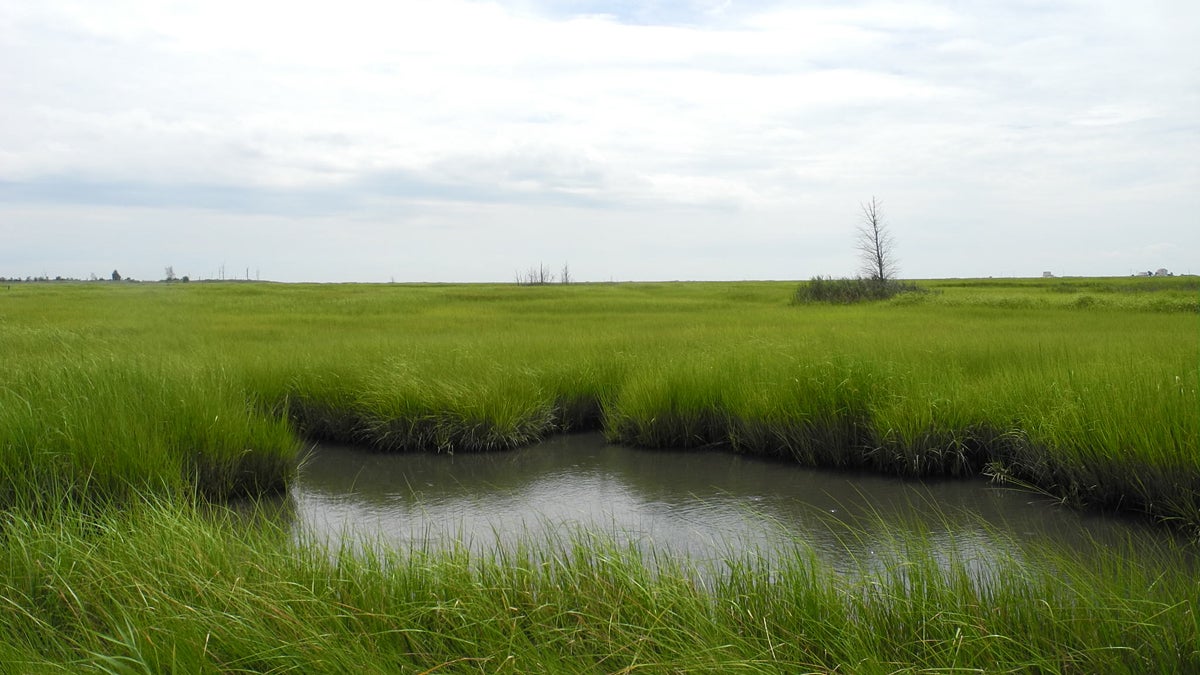New Jersey’s Cumberland County awaits Sandy aid

The so-called bottom of the world, where Cumberland County marshes line the Delaware Bay. (Tracey Samuelson/for NewsWorks)
“Welcome to the bottom of the world” – it’s a common greeting in the southern-most communities of Cumberland County, where New Jersey drops off into the Delaware Bay.
Paul Waterman calls the phrase to visitors to his Beaver Dam Boat Rentals, which he runs with his wife, Linda.
“We used to say that when we lived in Cape May, but now Cape May is populated, so now this is the bottom of the world,” he explains.
The Watermans live and work on the Orinokin Creek in Newport, New Jersey. They tow customers in small fiberglass boats about a mile and a half out into the marsh, anchor them, and let them catch crabs for a few hours before towing them back in. A bald eagle watches from a nest nearby.
But the remoteness that gives this place its beauty isolates it, too. Residents in Cumberland, the state’s poorest county, often lament that they’re forgotten by the rest of the state – especially regarding aid for rebuilding after Superstorm Sandy. Much of the first wave of grants – $1.8 billion dollars – is targeted at the nine counties with the most damage from the storm. Cumberland isn’t one of them.
“So we cannot even get that money, although people have teased us with it,” Linda said. “We’ve been to several meetings where it’s been brought up, New Jersey Stronger Grants, ‘Oh, but you’re in Cumberland County? Never mind.’ Literally, ‘never mind.’”
A County-Level Approach
Some of the grants for homeowners – like $10,000 offered to people who agree to remain in their county and up to $150,000 for home elevating and rebuilding costs – are only open to people in those nine most-damaged counties. In other grants, such as those targeted to landlords and businesses, the nine counties receive priority.
The proportion of people who live by the water in Cumberland is relatively small; therefore, at the county-level, storm damage from Sandy appears minimal.
“But if you just take Downe Township, our loss was about over 9 percent [of the town’s tax base],” said Mayor Bob Campbell. “That percentage was so tiny compared to the whole county’s revenue and ratable base, so we didn’t qualify.”
In Fortescue, a village in Downe Township, the storm caused severe damage, knocking a handful of homes off their foundations into the bay, similar to scenes in Mantoloking up north.
“They say we’re not going to be included in this round of funding, maybe next round,” said Campbell. “We can’t survive on maybes. We have to do things today.”
The New Jersey Department of Community Affairs, which administers many grants for homeowners, declined an interview. But a spokeswoman said they understand the impact in Cumberland County and pointed out residents have received $3 million in FEMA grants and Downe Township got a $200,000 loan.
Long-standing Frustrations
Frustrations about the flow of recovery funds are also common in Atlantic County and in the Barnegat Bay communities. But in Cumberland, the absence of aid confirms long-held beliefs about government.
“The years of neglect that are perceived in this area have made the residents and businesses almost expect not to get help,” said Meghan Wren, the director of the nonprofit Bayshore Center at Bivalve.
“I feel like they gave all the money to rich people who went to college in all the high-income counties,” said John Gillian, a retired veteran and part-time bus mechanic who is currently displaced from his home in Gandys Beach, part of Downe Township. He was turned down for two ReNew Jersey Stronger grants because he lives in Cumberland County.
“I wouldn’t live anywhere else in the state of New Jersey but here” said Don Stine, secretary of the Fortescue Captains’ Association, which runs the local marina. “The only thing is, the bad features of it are we get no outside help here. What we do we have to do from within.”
A Dose of Hope
Both Meghan Wren and Mayor Campbell are optimistic that the county will eventually receive funding.
Just this week, a long-awaited dredging project began clearing Fortescue Creek, which was choked with sand from the storm and blocked boats from coming and going at low tide. After months of campaigning by local fishermen and town officials, a special appropriation through the Department of Transportation will fund the $300,000 project.
But oyster boats in nearby Nantuxent Creek are waiting for their dredging project to be funded.
“We have a timeframe where we have to be into the dock at a certain time to get the product to refrigeration,” explained oysterman Scott Bailey. “Because [Sandy] filled the creek in, sometimes we have to quit a couple hours early in order make it in before low water so we don’t get stuck out there.”
Shorter work days mean a smaller haul. Bailey estimates his expenses have climbed 15 to 20 percent relative to his catch.
WHYY is your source for fact-based, in-depth journalism and information. As a nonprofit organization, we rely on financial support from readers like you. Please give today.




